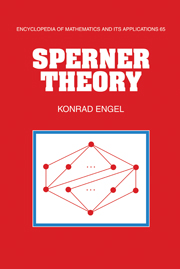Book contents
- Frontmatter
- Contents
- Preface
- 1 Introduction
- 2 Extremal problems for finite sets
- 3 Profile-polytopes for set families
- 4 The flow-theoretic approach in Sperner theory
- 5 Matchings, symmetric chain orders, and the partition lattice
- 6 Algebraic methods in Sperner theory
- 7 Limit theorems and asymptotic estimates
- 8 Macaulay posets
- Notation
- Bibliography
- Index
6 - Algebraic methods in Sperner theory
Published online by Cambridge University Press: 08 January 2010
- Frontmatter
- Contents
- Preface
- 1 Introduction
- 2 Extremal problems for finite sets
- 3 Profile-polytopes for set families
- 4 The flow-theoretic approach in Sperner theory
- 5 Matchings, symmetric chain orders, and the partition lattice
- 6 Algebraic methods in Sperner theory
- 7 Limit theorems and asymptotic estimates
- 8 Macaulay posets
- Notation
- Bibliography
- Index
Summary
In this chapter we are concerned with unweighted, ranked posets only. Algebraic characterizations for the existence of certain matchings in graphs have been known for many years (cf. Lovász and Plummer [356], and note in particular the results of Kasteleyn [286], Perfect [380], and Edmonds [142]). We have seen that chains in posets can be constructed by joining matchings between consecutive levels. By Dilworth's theorem, the size of chain partitions is related to the width of a poset. For these (and other related) reasons, it is worthwhile to develop an algebraic machinery that answers many questions in Sperner theory. An essential step in this direction was undertaken by Stanley [439], who used deeper results from algebraic geometry (the Hard Lefschetz Theorem) in order to prove the Sperner property of several posets. Further work (in particular that of Proctor [388]) allows us to stay on a more or less elementary linear algebraic level. It is interesting that Erdős–Ko–Rado type theorems can also be proved using this approach. Important contributions were those of Lovász [355] and Schrijver [419] and some culmination was achieved by Wilson's [470] exact bound for the Erdős–Ko–Rado Theorem in the Boolean lattice. Besides this result, Wilson strongly influenced, in general, the development of the algebraic extremal set theory and, together with Kung (e.g., [327, 328]), the theory of geometric (and related) lattices. Kung's main tool is the finite Radon transform discovered by E. Bolker (see [328]), but we will formulate the results in the language of injective linear operators. Extremal set problems are discussed in Section 2.5.
Information
- Type
- Chapter
- Information
- Sperner Theory , pp. 208 - 303Publisher: Cambridge University PressPrint publication year: 1997
